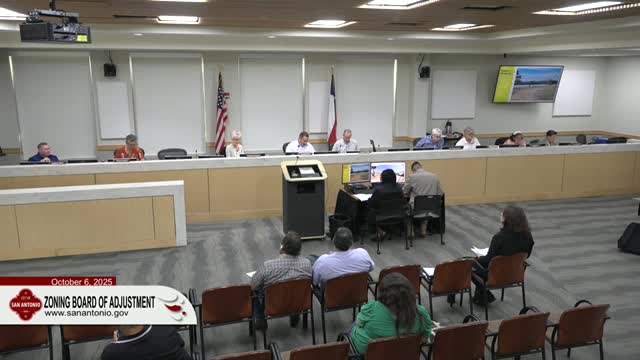Board Approves Jesus Torres Day's Variance for Security Fence at 203 West Buchanan Boulevard
October 06, 2025 | San Antonio, Bexar County, Texas
This article was created by AI summarizing key points discussed. AI makes mistakes, so for full details and context, please refer to the video of the full meeting. Please report any errors so we can fix them. Report an error »

The Board of Adjustment meeting held on October 6, 2025, in San Antonio, Texas, addressed several key variance requests impacting local properties. The meeting began with a motion to approve a variance for a property located at 203 West Buchanan Boulevard, submitted by applicant Jesus Torres Day. The request involved allowing the use of corrugated metal for a fence in the rear yard, which was deemed necessary for enhanced security and privacy. The board found that enforcing the existing development code would result in unnecessary hardship for the applicant, as the fence was already constructed. The motion passed unanimously, with board members expressing support for the decision based on the unique circumstances of the property.
Following this, the board reviewed a second case concerning a vacant lot at 519 West Highland Boulevard, where applicant Gina Perez sought variances to reduce the minimum lot size and width requirements for a new single-family home. The property, previously home to a residence that was demolished due to fire damage, required a 400 square foot variance from the 6,000 square foot minimum lot size and a 10-foot variance from the 50-foot minimum lot width. Staff recommended approval, noting that the variances would not alter the neighborhood's character and would facilitate the development of a new home. The board unanimously approved the request, highlighting the positive community support for the project.
The final case discussed involved a request from Steven G. Cook Engineering for a property at 3038 Eisenhower Road. The applicant sought a 145-foot variance from the maximum allowable front setback and a 30-foot variance from the minimum required rear setback. This case was set for further discussion, as the board chair recused himself from the proceedings.
Overall, the meeting underscored the board's commitment to balancing property rights with community standards, as they navigated the complexities of zoning regulations and individual property needs. The next steps for the discussed cases will involve finalizing the approved variances and monitoring their implementation in the respective neighborhoods.
Following this, the board reviewed a second case concerning a vacant lot at 519 West Highland Boulevard, where applicant Gina Perez sought variances to reduce the minimum lot size and width requirements for a new single-family home. The property, previously home to a residence that was demolished due to fire damage, required a 400 square foot variance from the 6,000 square foot minimum lot size and a 10-foot variance from the 50-foot minimum lot width. Staff recommended approval, noting that the variances would not alter the neighborhood's character and would facilitate the development of a new home. The board unanimously approved the request, highlighting the positive community support for the project.
The final case discussed involved a request from Steven G. Cook Engineering for a property at 3038 Eisenhower Road. The applicant sought a 145-foot variance from the maximum allowable front setback and a 30-foot variance from the minimum required rear setback. This case was set for further discussion, as the board chair recused himself from the proceedings.
Overall, the meeting underscored the board's commitment to balancing property rights with community standards, as they navigated the complexities of zoning regulations and individual property needs. The next steps for the discussed cases will involve finalizing the approved variances and monitoring their implementation in the respective neighborhoods.
View full meeting
This article is based on a recent meeting—watch the full video and explore the complete transcript for deeper insights into the discussion.
View full meeting
